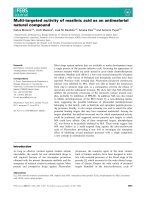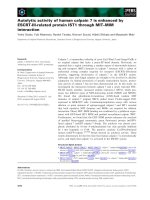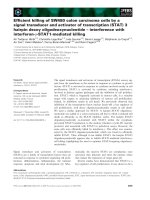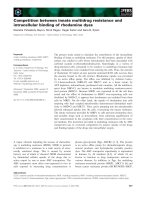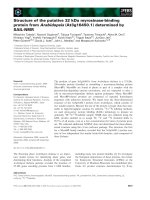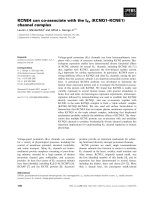Tài liệu Báo cáo khoa học: Protein farnesyltransferase inhibitors interfere with farnesyl diphosphate binding by rubber transferase pdf
Bạn đang xem bản rút gọn của tài liệu. Xem và tải ngay bản đầy đủ của tài liệu tại đây (304.19 KB, 7 trang )
Protein farnesyltransferase inhibitors interfere with farnesyl
diphosphate binding by rubber transferase
Christopher J. D. Mau
1
, Sylvie Garneau
2
, Andrew A. Scholte
2
, Jennifer E. Van Fleet
1
, John C. Vederas
2
and Katrina Cornish
1
1
USDA, Agricultural Research Service, Western Regional Research Center, Albany, CA, USA;
2
Department of Chemistry,
University of Alberta, Edmonton, Alberta, Canada
Rubber transferase, a cis-prenyltransferase, catalyzes the
addition of thousands of isopentenyl diphosphate (IPP)
molecules to an allylic diphosphate initiator, such as farnesyl
diphosphate (FPP, 1), in the presence of a divalent metal
cofactor. In an effort to characterize the catalytic site of
rubber transferase, the effects of two types of protein
farnesyltransferase inhibitors, several chaetomellic acid A
analogs (2, 4–7)anda-hydroxyfarnesylphosphonic acid (3),
on the ability of rubber transferase to add IPP to the allylic
diphosphate initiator were determined. Both types of com-
pounds inhibited the activity of rubber transferases from
Hevea brasiliensis and Parthenium argentatum, but there
were species–specific differences in the inhibition of rubber
transferases by these compounds. Several shorter analogs
of chaetomellic acid A did not inhibit rubber transferase
activity, even though the analogs contained chemical
features that are present in an elongating rubber molecule.
These results indicate that the initiator-binding site in rubber
transferase shares similar features to FPP binding sites in
other enzymes.
Keywords: Hevea brasiliensis; Parthenium argentatum;
chaetomellic acid A; hydroxyfarnesylphosphonic acid.
Rubber transferase catalyzes the biosynthesis of natural
rubber [1]. To form this polymer of cis-polyisoprene, rubber
transferase adds up to thousands of molecules of isopente-
nyl diphosphate (IPP) to a single initiating allylic diphos-
phate, usually considered to be farnesyl diphosphate (FPP,
1,Fig.1)asthein vivo substrate. However, rubber
transferase can also use other allylic diphosphates as
initiators; this substrate flexibility is probably a reflection
on the manner in which the catalytic site deals with the
elongating rubber polymer. In addition, a divalent metal
cofactor, such as Mg
2+
, is required. In spite of the
dependence of modern industrial society on natural rubber,
the biochemical properties of rubber transferase are only
partially understood [1–6].
Several compounds are known to bind to FPP sites in
other enzymes that use FPP as a substrate. Most of these
substances have been discovered as a result of oncogenesis
studies involving protein farnesyltransferases. Chaetomel-
lic acid A (2) (Fig. 1), made by Chaetomella acutiseta,isan
inhibitor of protein farnesyltransferases (PFTs), such as
those that modify Ras, and competes for the FPP binding
site of PFTs with an IC
50
of 55 n
M
[7]. Derivatives of
chaetomellic acid A have also been found to inhibit PFTs
[8]. a-Hydroxyfarnesylphosphonic acid (HFPA, 3) (Fig. 1)
is another compound shown to inhibit PFTs [9] with an
IC
50
of 30 n
M
[7].
In an effort to characterize the FPP binding site of rubber
transferase, we have tested the ability of chaetomellic acid A
and several analogs, as well as HFPA, to inhibit rubber
biosynthesis in vitro. We have used rubber transferases from
Hevea brasiliensis and Parthenium argentatum to determine
if there are similarities in enzymatic behavior that might be
characteristic of rubber transferases in general, as well as
species-specific differences.
Materials and methods
Chemicals
Chemicals were purchased from Sigma Chemical Com-
pany unless otherwise noted. Farnesyl diphosphate (FPP),
dimethyl allyl diphosphate (DMAPP) and [1-
14
C]IPP (2.04
GBqÆmmol
)1
) were purchased from American Radiolabe-
led Chemicals, Inc. (St. Louis, MO, USA). a-Hydroxy-
farnesylphosphonic acid (HFPA) was purchased from
Calbiochem-Novabiochem Corp. Washed rubber particles
(WRP) from P.argentatum and H. brasiliensis were
purified ([10,11], respectively) and stored in liquid nitrogen
[12].
Synthesis of chaetomellic acid A analogs
Several analogs of chaetomellic acid, purified as lithium
salts, were made according to Ratemi et al.[8].The
structures of (Z)-2-octyl-3-methylbutenedioic acid dilithium
Correspondence to K. Cornish, Western Regional Research Center,
USDA-ARS 800 Buchanan Street, Albany, CA 94710, USA.
Fax: + 1 510 559 5663, Tel.: + 1 510 559 5950,
E-mail:
Abbreviations: DMAPP, dimethyl allyl diphosphate; FPP, farnesyl
diphosphate; IPP, isopentenyl diphosphate; HFPA, a-hydroxyfarne-
sylphosphonic acid; PFT, protein farnesyltransferase; WRP, washed
rubber particles; UDP, undecaprenyl diphosphate.
(Received 5 June 2003, revised 8 July 2003, accepted 31 July 2003)
Eur. J. Biochem. 270, 3939–3945 (2003) Ó FEBS 2003 doi:10.1046/j.1432-1033.2003.03775.x
salt (4)(Z)-2-nerolyl-3-methylbutenedioic acid dilithium salt
(5)(Z)-2-farnesyl-3-methylbutenedioic acid dilithium salt
(6), and (Z)-2-geranyl-3-methylbutenedioic acid dilithium
salt (7) are shown in Fig. 1. Concentrated stock solutions of
chaetomellic acid A analogs (4–7) were prepared in
dimethylsulfoxide at 2 m
M
.
Reaction conditions
Rubber transferase assays were performed in multiwell
plates as described in Mau et al. [13]. The typical reaction
assay contained 1 m
M
[1-
14
C]IPP (7.03 MBqÆmmol
)1
),
1.25 m
M
MgSO
4
,5m
M
dithiothreitol and 100 m
M
Tris
pH 7.5 in a total volume of 50 lL. Various concentrations
of initiators (FPP or DMAPP) were added, ranging from
10 p
M
to 1 m
M
, along with the stated concentrations of
chaetomellic acid A analogs (4–7)orHFPA(3)(thatwas
dissolved in ethanol). For rubber transferase assays (all
performed in triplicate), 0.5 mg of H. brasiliensis WRP
was used; 0.25 mg of WRP was used per assay involving
P.argentatum rubber transferase. The reactions were
started by the addition of WRPs to the other components
and were incubated at 25 °CforH. brasiliensis WRP and
16 °CforP.argentatumWRP. The assays were incubated
for 4 h and were stopped by the addition of 0.5
M
EDTA
pH 8 to a final concentration of 20 m
M
. The incorporated
14
C was measured by liquid scintillation counting of the
newly synthesized rubber which had been trapped on
filters and subsequently washed to remove unincorporated
[
14
C]IPP.
Results
Effects of various organic solvents and lithium salts
on rubber transferase activity
Prior to the first assays involving the analogs, several
organic solvents that could be used to dissolve the chaeto-
mellic acid A analogs were added to the standard rubber
transferase assay [13] to determine what effects the presence
of these solvents had on enzymatic activity. The range of
concentrations tested were typical working dilutions.
Dimethylsulfoxide and ethanol did not inhibit rubber
transferase activity at the final concentration of 10% (v/v)
in the rubber transferase assay, so these were the chosen
conditions for conducting the inhibitor studies (data not
shown).
As the chaetomellic acid A analogs (4–7) were synthes-
ized as lithium salts, the effect of lithium cations on rubber
transferase activity was also evaluated. The presence of LiCl
in the amounts of 1 l
M
to 1 m
M
did not affect rubber
transferase activity (data not shown).
As a result, all subsequent assays involving analogs 4–7
were compared to internal controls containing comparable
amounts of LiCl and dimethylsulfoxide. Within any
experiment in which the chaetomellic acid A analogs were
diluted serially, the final dimethylsulfoxide concentration
was kept constant at 10%. Assays involving HFPA were
compared to control reactions supplemented with ethanol,
and serial dilutions of HFPA were made to maintain a final
ethanol concentration of 10%.
Fig. 1. Structures of various chemicals tested
for effects on rubber transferase activity in vitro.
Farnesyl diphosphate 1 is the presumed initi-
ator in vivo. Chaetomellic acid A (SG-2–29, 2)
and a-hydroxyfarnesylphosphonic acid
(HFPA, 3) are known inhibitors of protein
farnesyltransferases, which covalently modify
proteins with a FPP molecule. (Z)-2-octyl-3-
methylbutenedioic acid dilithium salt
(SG-2–96, 4)(Z)-2-nerolyl-3-methyl-
butenedioic acid dilithium salt (SG-1–27, 5)
(Z)-2-farnesyl-3-methylbutenedioic acid
dilithium salt (SG-1–29, 6), and (Z)-2-geranyl-
3-methylbutenedioic acid dilithium salt (SG-
1–30, 7) are analogs of chaetomellic acid A.
3940 C. J. D. Mau et al.(Eur. J. Biochem. 270) Ó FEBS 2003
Chaetomellic acid A analogs inhibit rubber transferase
Hevea brasiliensis. Incubating H. brasiliensis WRP with
20 l
M
chaetomellic acid A (2) and varying amounts of
DMAPP or FPP initiator in a rubber transferase enzymatic
assay demonstrated that chaetomellic acid A (2) was inhi-
bitory when present at 20-fold molar excess of DMAPP or
200-fold molar excess FPP (Fig. 2). The related compound
4 inhibited H. brasiliensis rubber transferase by 40% when
included at 180 l
M
in the presence of 10 n
M
FPP (data not
shown).
Compounds 5, 6 and 7 (Fig. 1) were tested for inhibitory
effects on H. brasiliensis rubber transferase in vitro.Com-
pound 5 was made to resemble the first cis-elongation
product formed when using DMAPP as an initiator, while
compounds 6 and 7 were synthesized to resemble FPP and
geranyl diphosphate, respectively. Compound 6 inhibited
activity by 25% when present in the assay at 180 l
M
in
1800-fold molar excess of FPP. Compounds 5 and 7 were
not inhibitory when included in the assay at 180 l
M
in over
a million-fold molar excess of initiator.
Parthenium argentatum. All five chaetomellic acid A ana-
logs (2, 4, 5, 6 and 7) were tested using the rubber transferase
from guayule, P.argentatum, a species phylogenetically
distant from H. brasiliensis. Compounds 2 and 6 reduced
rubber transferase activity by 27% (when added at 180 l
M
in a 18,000-fold molar excess) and by 48% (when present
at 180 l
M
in a 180-fold molar excess), respectively.
Compounds 4, 5 and 7 did not inhibit rubber transferase
activity under the conditions tested (supplemented in the
assay at 180 l
M
in over a million-fold molar excess).
Because compounds 2 and 6 were more inhibitory than 4
and 7, respectively, the long hydrophobic tails on these
molecules might have some important role in determining
efficacy of inhibition. To examine this possibility, palmitic
acid and stearic acid were tested to see if either had any
effect on rubber transferase activity. When present at
180 l
M
, neither palmitate nor stearate inhibited IPP incor-
poration into DMAPP- or FPP-initiated newly synthesized
rubber by H. brasiliensis or P.argentatum (data not
shown).
a-Hydroxyfarnesylphosphonic acid also inhibits rubber
transferases. As chaetomellic acid A had been described
initially as an inhibitor of protein farnesyltransferase,
another type of PFT inhibitor was also tested to determine
if it also could inhibit rubber transferase activity. HFPA
inhibited FPP utilization by H. brasiliensis and P.argent-
atum WRP by 36–37% when present at 20 l
M
at 2000-fold
molar excess.
Determination of kinetic constants for chaetomellic acid
A analogs and HFPA. Double reciprocal plots (1/v vs.
1/[FPP]) of kinetic experiments indicated that compounds 2
and 3 were competitive inhibitors of H. brasiliensis rubber
transferase (Fig. 3A,B), whereas compound 6 was a
noncompetitive inhibitor (Fig. 3C). In contrast, all three
compounds behaved as competitive inhibitors of the
P.argentatumrubber transferase (Fig. 4A–C).
The apparent K
i
s for the chaetomellic acid A analogs and
HFPA were determined from plots (not shown) of the slope
of the each reciprocal plot vs. the concentration of the
inhibitory compound [14] (Table 1).
Discussion
Rubber transferases exhibit a considerable degree of toler-
ance and can bind to a variety of different sizes of allylic
diphosphate initiator molecules, at least up to solanesyl
(C
45
) diphosphate (M. H. Chapman and K. Cornish,
unpublished data). Furthermore, the affinity of rubber
transferase for the initiator increases with the size of the
initiator, up to FPP (C
15
)inP. argentatum and geranylger-
anyl diphosphate (C
20
)inH. brasiliensis. As a result, a
model was proposed for the rubber transferase active site,
envisioning the presence of non–specific hydrophobic
interactions, which increased the affinity for longer allylic
diphosphate substrates [15]. Nevertheless, it was uncertain if
the chaetomellic acid analogs with the diacid groups could
occupy the initiator-binding site with enough affinity to
inhibit rubber biosynthesis.
As seen in Fig. 2, chaetomellic acid A (2) was able to
interfere with IPP incorporation in the rubber transferase
assay. Almost 10-times more DMAPP than FPP was
needed to overcome the same degree of inhibition by
chaetomellic acid A (2) (Fig. 2). The ability of DMAPP or
FPP to displace chaetomellic acid A from the initiator-
binding site in H. brasiliensis rubber transferase paralleled
the ninefold lower affinity of the enzyme for DMAPP vs.
FPP (K
m,DMAPP
of 13.2 and K
m,FPP
of 1.5 l
M
[1]).
The length of the hydrophobic carbon tail also affected
the inhibitory activity of the chaetomellic acid A analogs.
Compound 6, which has a farnesyl tail, was weakly
inhibitory at 180 l
M
, in both species, whereas 7,which
has a shorter geranyl tail, was not inhibitory at all.
Fig. 2. Chaetomellic acid A inhibits H. brasiliensis rubber transferase.
Assays were performed using H. brasiliensis WRP, 1 m
M
[
14
C]IPP, an
allylic diphosphate initiator, and either chaetomellic acid A (SG-2–29)
or its analog SG-2–96. DMAPP was varied in the presence of 20 l
M
SG-2–29 (d)or20l
M
SG-2–96 (s), while various concentrations of
FPP were tested in combination with 20 l
M
SG-2–29 (.). The amount
of [
14
C]IPP incorporated in these reactions was compared to control
reactions containing dimethylsulfoxide and LiCl instead of the
chaetomellic acid A analogs.
Ó FEBS 2003 Inhibition of rubber transferase (Eur. J. Biochem. 270) 3941
Chaetomellic acid A (2) with a 14-carbon aliphatic chain
strongly inhibited H. brasiliensis rubber transferase at
20 l
M
while 4, with a similar structure but having a shorter
8-carbon tail, required 180 l
M
before it became inhibitory.
On the other hand, P.argentatum rubber transferase
activity was only weakly inhibited by 180 l
M
chaetomellic
acid A (2) and not at all by 180 l
M
compound 4. In both
cases, lengthening the hydrophobic surface of the analog
added additional interactions, which increased the binding
affinity of the inhibitor for the initiator-binding site. The
difference in the inhibition of H. brasiliensis and P.argent-
atum rubber transferases by chaetomellic acid A indicated
that there may be differences in the catalytic site geometry
between the two species.
However, a hydrophobic aliphatic tail simply attached to
anegativechargeisnotthesolecauseoftheobserved
inhibitory activity, because neither palmitic nor stearic acid
was inhibitory in either species (data not shown). High
affinity binding of substrates in the catalytic site appears to
require two negatively charged oxygen atoms at one end of
the molecule.
These criteria are met by a-hydroxyfarnesylphosphonic
acid (3), which did inhibit rubber transferase activity in both
species. That two types of protein farnesyltransferase
inhibitors could also interfere with rubber transferase, a
cis-prenyltransferase, indicates that the initiator binding site
of rubber transferase shares similarities with the FPP
binding site of the protein farnesyltransferases.
For P.argentatumrubber transferase, compounds 2, 3
and 6 all appear to inhibit FPP binding (and subsequent IPP
incorporation) competitively (Figs 4A–C). In contrast,
although 2 and 3 both competitively inhibited the H. bra-
siliensis rubber transferase (Figs 3A,B), 6 actedina
noncompetitive manner (Fig. 3C).
The calculated K
i
s show that the active sites of
H. brasiliensis and P. argentatum rubber transferases have
a higher affinity for 2 than for 6 (Table 1). While the
allylic compound 6 more closely resembles the FPP
initiator, compound 2 with its more flexible aliphatic
backbone probably makes more extensive contact with
the nonspecific hydrophobic surface lining the catalytic
cavity [15]. Alternatively, the difference in length of the
inhibitors allows 2 to interact with the polyisoprene
molecules within the rubber particle. In both cases, the
additional interactions result in tighter binding of 2 when
compared to that of 6.
The interpretation of the double reciprocal plots must be
qualified because the rubber transferase active site is
localized on the surface of a rubber particle [15]. This
proximity to the membrane monolayer covering the rubber
particle would preclude access to the active site from certain
directions during the in vitro reactions. In addition, experi-
mental manipulations of washed rubber particles can be
challenging.
The binding of competitive inhibitors and substrates are
mutually exclusive, which is not the case for noncompetitive
inhibitors. Non-competitive inhibition results when binding
of an inhibitor at a second site prevents catalysis at the
normal active site, without causing any changes in the
binding kinetics at the active site. The P. argentatum rubber
transferase can only bind 6 in a manner which affects the
apparent binding at the initiator substrate site. On the other
Fig. 3. Chaetomellic acid A and SG-1–29 are inhibitors of H. brasil-
iensis rubber transferase. Double reciprocal plots of 1/v vs. 1/[FPP]
were created using kinetic data from H. brasiliensis rubber transferase
assays. Rubber transferase assays were conducted in the presence of
H. brasiliensis WRP, 1 m
M
[
14
C]IPP, and the indicated amounts of
FPP. ÔvÕ is measured in units of lmol [
14
C]IPP incorporated per g dry
weight rubber per 4 h. (A) Chaetomellic acid A (SG-2–29) was inclu-
ded at concentrations of 10 (.), 20 (s)or50(d) l
M
during the assay
while FPP was varied from 10 n
M
to 100 n
M
.(B)HFPAwaspresentat
10 (.), 20 (s), or 40 (d) l
M
while FPP was varied from 10 n
M
to
50 n
M
. (c). SG-1–29 was added at final concentrations of 50 (.), 100
(s), or 200 (d) l
M
while FPP was varied from 10 n
M
to 100 n
M
.
3942 C. J. D. Mau et al.(Eur. J. Biochem. 270) Ó FEBS 2003
hand, the noncompetitive inhibition by 6 of H. brasiliensis
rubber transferase may be caused by interference resulting
from the additional binding of compound 6 at the IPP
binding site, which is in the proximity of the allylic
diphosphate binding site. Competition between IPP and
allylic diphosphate for the IPP binding sites has been
observed at high substrate concentrations [1,16], and 6 was
present at a range of 2500 to 10 000-fold molar excess to
FPPintheassay(30-to130-timestheK
m
for FPP [17]).
These results suggest that the spatial orientation between the
IPP and initiator binding sites differs between the two
rubber transferases, as well as the ability to bind 6 at other
surfaces within the active site.
The different behavior between the two rubber trans-
ferases towards 6 should also be considered in light of the
cooperative effects between IPP and FPP if one assumes
that 6 is perceived as FPP by both enzymes. In the range of
concentrations of 6 incubated in the assays, the two rubber
transferases exhibit different degrees of negative coopera-
tivity, with the P. argentatum enzyme showing the strongest
effect [17]. Under these conditions, binding of the first
initiator molecule decreases the ability of a free FPP to
displace the bound FPP (or elongating polymer). The ability
of the FPP-like compound 6 to bind noncompetitively at an
additional location within the H. brasiliensis active site may
explain some of differences in the degree of negative
cooperativity between the two enzymes. Furthermore, the
development of the P.argentatumrubber transferase with a
low K
m
for FPP (about 150-fold lower in concentration than
the corresponding constant for H. brasiliensis [17]) may also
explain the difference in degree of negative cooperativity,
because compound 6 can bind competitively into the
initiator site of the P.argentatum enzyme, unlike the
noncompetitive binding in the vicinity of the weaker affinity
initiator binding site of the H. brasiliensis protein. More
experimentation to elucidate the mechanism of the negative
cooperativity can be performed, but the basis for this
behavior will probably only become apparent after the
crystal structures of the rubber transferases have been
determined.
The differing behavior of the various compounds tested,
both in the amount of compound needed to create an
observable effect and the different types of inhibition
effected, supports earlier kinetic data on cosubstrate effects
among the species [16,17]. Differences in binding constants,
competitive effects, and in substrate activation exist between
species [1,15–17]. Thus, although the rubber transferases
Fig. 4. SG-1–29 and HFPA are competitive inhibitors of P. argentatum
rubber transferase. Double reciprocal plots of 1/v vs. 1/[FPP] were
created using kinetics data from P. argentatum rubber transferase
assays. Rubber transferase assays were conducted in the presence of
P.argentatumWRP, 1 m
M
[
14
C]IPP, and the indicated amounts of
FPP. ÔvÕ is measured in vitro of lmol [
14
C]IPP incorporated per g dry
weight rubber per 4 h. (A) Chaetomellic acid A (SG-2–29) was added
at 50 (.), 100 (s), or 200 (d) l
M
while FPP was varied from 1.3 n
M
to
50 n
M
. (B) Assays contained HFPA at concentrations of 100 (.), 200
(s), or 500 (d) l
M
while FPP was varied from 5 n
M
to 100 n
M
.(C)
SG-1–29 was present at final concentrations of 50 (.), 100 (s), or 200
(d) l
M
while FPP was varied from 5 n
M
to 100 n
M
.
Table 1. Kinetic constants determined for the interaction between cha-
etomellic acid A analogs or a-hydroxyfarnesylphosphonic acid with
H. brasiliensis and P. argentatum rubber transferases.
Compound
H. brasiliensis P. argentatum
K
i
(l
M
)
Type of
competitor K
i
(l
M
)
Type of
competitor
SG-2–29 (2) 42 competitive 8.8 competitive
HFPA (3) 64 competitive 420 competitive
SG-1–29 (6) 140 noncompetitive 25 competitive
Ó FEBS 2003 Inhibition of rubber transferase (Eur. J. Biochem. 270) 3943
from different species share many commonalities, they are
not identical. These differences may have resulted from
evolutionary divergence alone or in combination with the
development of a different cellular environment for the
rubber transferase in each species; H. brasiliensis rubber
transferase is found on rubber particles in a free-flowing
latex in laticifers, while P.argentatumrubber transferase
is located on intracellular rubber particles in the bark
parenchyma.
The discovery that compounds known to bind to other
FPP binding sites can interact with the initiator binding site
of rubber transferases opens a new approach to modeling
the catalytic site of this enzyme in the absence of crystal
structures. We have already used other biochemical and
physical studies to elucidate some features of the catalytic
site [1,18].
Recently, two crystal structures of undecaprenyl
diphosphate (UDP) synthase, a cis-prenyltransferase that
catalyzes the formation of a 55-carbon carrier for glycosyl
residues in peptidoglycan synthesis in bacteria, have been
published [19,20]. Information from these structures may be
helpful in our efforts to model the rubber transferase active
site because both enzymes are cis-prenyltransferases with
proposed catalytic sites near the cytosolic surface of the
membrane. The active site contains a cleft flanked by
hydrophobic amino acids that surrounds the aliphatic
backbone of the substrate [20]. The chain length is
apparently regulated by the size of the active site, and site-
directed mutants, in which bulky, hydrophobic residues at
the distal end of the catalytic site have been converted to
alanine, can produce longer polyprenyl molecules. Similar
mutagenesis of the avian FPP synthase catalytic site also
extends the size of the product formed [21]. These structures
suggest that the rubber transferase has a hydrophobic
channel to direct the elongating biopolymer, in this case to
the rubber particle interior [1,15,18]. Unlike the UDP
synthase and the FPP synthase, rubber transferase appears
to lack the bulky hydrophobic residues at the distal end of
the active site. The normal mechanism for releasing the
rubber molecule from the enzyme has not been determined.
Thus, the results presented here further support the
proposed model for the rubber transferase active site in
which the presence of non–specific hydrophobic interactions
increase the affinity for longer allylic diphosphate substrates
[1,15]. These results also indicate that structural differences
do exist between the rubber transferases from evolutionarily
divergent species.
Acknowledgements
We thank Dr R. Krishnakumar at the Rubber Research Institute of
India for supplying the H. brasiliensis latexasasourceforWRPand
Dr Francis Nakayama at the US Water Conservation Laboratory in
Phoenix, AZ for maintaining and harvesting P.argentatumplants for
isolation of the P. argentatum WRP used in experiments described here.
We also acknowledge the help of Ms. Mary H. Chapman and Dr Javier
Castillo
´
n for isolating the H. brasiliensis and P. argentatum WRP used
in our experiments. Ms. Saima Kint and Dr Thomas McKeon kindly
provided palmitic and stearic acids for control experiments. Part of this
work has been supported by the Natural Sciences and Engineering
Research Council of Canada and the Alberta Heritage Foundation for
Medical Research.
References
1. Cornish, K. (2001) Similarities and differences in rubber bio-
chemistry among plant species. Phytochemistry 57, 1123–1134.
2. Park, R.B. & Bonner, J. (1958) Enzymatic synthesis of rubber
from mevalonic acid. J. Biol. Chem. 233, 340–343.
3. Berndt, J. (1963) The Biosynthesis of Rubber. pp 1–22. US Gov-
ernment Research Report AD-601729.
4. Lynen, F. (1969) Biochemical problems of rubber synthesis.
J. Rubber Res. Inst Malaya 21, 389–406.
5. Archer, B.L. & Audley, B.G. (1987) New aspects of rubber bio-
synthesis. Bot. J. Linnean Soc. 94, 181–196.
6. Benedict, C.R., Madhavan, S., Greenblatt, G.A., Venkatachalam,
K.V. & Foster, M.A. (1989) The enzymatic synthesis of rubber
polymer in Parthenium argentatum Gray. Plant Physiol. 92,
816–821.
7. Gibbs, J.B., Pompliano, D.L., Mosser, S.D., Rands, E., Lingham,
R.B., Singh, S.B., Scolnick, E.M., Kohl, N.E. & Oliff, A. (1993)
Selective inhibition of farnesyl-protein transferase blocks ras
processing in vivo. J. Biol. Chem. 268, 7617–7620.
8. Ratemi, E.S., Dolence, J.M., Poulter, C.D. & Vederas, J.C. (1996)
Synthesis of protein farnesyltransferase and protein geranylger-
anyltransferase inhibitors: Rapid access to chaetomellic acid A
and its analogs. J. Org. Chem. 61, 6296–6301.
9. Pompliano, D.L., Rands, E., Schaber, M.D., Mosser, S.D.,
Anthony, N.J. & Gibbs, J.B. (1992) Steady-state kinetic mechan-
ism of Ras farnesyl: protein transferase. Biochemistry 31, 3800–
3807.
10. Cornish, K. & Backhaus, R.A. (1990) Rubber transferase
activity in rubber particles of guayule. Phytochemistry 29, 3809–
3813.
11. Siler, D.J. & Cornish, K. (1993) A protein from Ficus
elastica rubber particles is related to proteins from Hevea
brasiliensis and Parthenium argentatum. Phytochemistry 32, 1097–
1102.
12. Cornish, K. & Bartlett, D.L. (1997) Stabilisation of particle
integrity and particle bound cis-prenyltransferase activity in
stored, purified rubber particles. Phytochem. Anal. 8, 130–134.
13. Mau, C.J.D., Scott, D.J. & Cornish, K. (2000) Multiwell filtration
system results in rapid, high-throughput rubber transferase
microassay. Phytochem. Anal. 11, 356–361.
14. Segel, I. (1975). Enzyme Kinetics. John Wiley and Sons, New
York, NY.
15. Cornish, K. (2001) Biochemistry of natural rubber, a vital raw
material, emphasizing biosynthetic rate, molecular weight and
compartmentalization, in evolutionarily divergent plant species.
Nat. Prod. Report 18, 182–189.
16. Castillo
´
n, J. & Cornish, K. (1999) Regulation of initiation and
polymer molecular weight of cis-1,4-polyisoprene synthesized in
vitro by particles isolated from Parthenium argentatum (Gray).
Phytochemistry 51, 43–51.
17. Cornish, K., Castillo
´
n, J. & Scott, D.J. (2000) Rubber mole-
cular weight regulation in vitro, in plant species that produce
high and low molecular weights in vivo. Biomacromolecules 1,
632–641.
18. Cornish, K., Wood, D.F. & Windle, J.J. (1999) Rubber par-
ticles from four different species, examined by transmission
electron microscopy and electron-paramagnetic-resonance spin
labeling, are found to consist of a homogeneous rubber core
enclosed by a contiguous, monolayer biomembrane. Planta 210,
85–96.
19. Fujihashi, M., Zhang, Y W., Higuchi, Y., Li, X Y., Koyama, T.
& Miki, K. (2001) Crystal structure of cis-prenyl chain elongating
enzyme, undecaprenyl diphosphate synthase. Proc. Natl Acad. Sci.
USA 98, 4337–4342.
3944 C. J. D. Mau et al.(Eur. J. Biochem. 270) Ó FEBS 2003
20. Ko,T P.,Chen,Y K.,Robinson,H.,Tsai,P C.,Gao,Y G.,
Chen, A.P C., Wang, A.H J. & Liang, P H. (2001) Mechanism
of product chain length determination and the role of a flexible
loop in Escherichia coli undecaprenyl-pyrophosphate synthase
catalysis. J. Biol. Chem. 276, 47474–47482.
21. Tarshis, L.C., Proteau, P.J., Kellogg, B.A., Sacchettini, J.C. &
Poulter, C.D. (1996) Regulation of product chain length by iso-
prenyl diphosphate synthases. Proc. Natl Acad. Sci. USA 93,
15018–15023.
Ó FEBS 2003 Inhibition of rubber transferase (Eur. J. Biochem. 270) 3945
